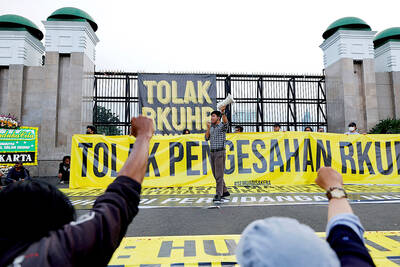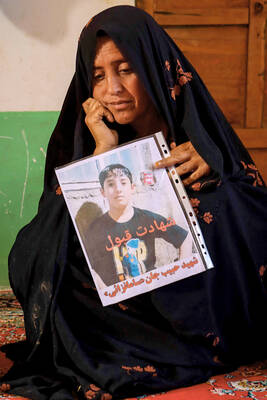The UN atomic agency said on Friday that Japan’s Onagawa nuclear power plant, despite having been closest to the epicenter of the earthquake and tsunami that struck the country last year, was in surprisingly good shape.
The structural elements of the plant were “remarkably undamaged given the magnitude of ground motion experienced and the duration and size of this great earthquake,” the International Atomic Energy Agency (IAEA) said in an initial report.
The Onagawa plant recorded temblors — “among the strongest of any plant affected by the earthquake” — that exceeded its design capacity and the basement of one of its reactor buildings flooded, but the plant maintained its cooling capacity, its reactors shut down without damage to their cores and there were no signs of major damage to crucial safety systems, the Vienna-based IAEA said.
The Fukushima Dai-ichi plant, 120km to the south, was not so lucky, suffering multiple reactor meltdowns and releasing radioactivity into the environment in the world’s worst nuclear accident in 25 years.
The IAEA report followed a two-week trip by 19 international experts that will be followed by further visits at Onagawa and reviews of other Japanese nuclear plants.
Findings will be added to an IAEA database being compiled by its International Seismic Safety Center (ISSC) that was part of the watchdog’s “action plan” on nuclear safety drawn up in the wake of the Fukushima disaster.
“The data we are collecting will make an important contribution to improving safety,” mission head Sujit Samaddar said. “Information in the database will allow IAEA member states to measure the performance of their nuclear power plants in the face of external hazards.”
In contrast, the magnitude 9.0 earthquake on March 11 last year knocked out a power line at the Fukushima Dai-ichi plant and generated a large tsunami that flooded its emergency generators, destroying the plant’s cooling systems. Catastrophic meltdowns occurred in three reactors, releasing radiation that has tainted the surrounding environment.
The plant has since stabilized, but more than 100,000 people still can’t go home due to radiation fears, while work to decommission the plant will take about 40 years. It was the world’s worst atomic accident since Chernobyl.
The Onagawa plant was about 70km from the quake’s epicenter, while Fukushima Dai-ichi was nearly 180km from the epicenter.
The tsunami was more than 13m high at both nuclear plants. Fukushima Dai-ichi’s seawall was built to withstand a tsunami of up 5.7m. Onagawa’s seawall was nearly 14m high and survived the tsunami. It has since been extended to nearly 17m above sea level.
Investigations by the government, the parliament and private groups have found that Tokyo Electric Power Co (TEPCO) underestimated the earthquake and tsunami risks faced by its plant at Fukushima despite a history of quakes in the region. The investigations have also criticized TEPCO and government regulators, which have developed cozy relationships, for ignoring safety standards and recommendations, including those by IAEA and other groups.
The IAEA visit from July 30 to Wednesday this week was its first to the Onagawa plant since the disaster. The group inspected the plant and interviewed dozens of workers and officials to assess how its structure, systems and components responded to the quake and its violent shakings.
Samaddar said he hoped to make similar inspections at other plants in Japan to share information and improve safety at nuclear power across the world. No visits are scheduled yet and would only take place at Japan’s invitation.
Five nuclear plants total suffered some level of damage from the earthquake and tsunami, but all but Fukushima Dai-ichi were shut down safely.
In May, the last of Japan’s 50 working reactors were turned off as safety checks were carried out, but two are now back online and generating power. Despite public protests, the government is eager to restart reactors because of the ballooning cost of fuel imports to keep the power supply running.

Indonesia yesterday began enforcing its newly ratified penal code, replacing a Dutch-era criminal law that had governed the country for more than 80 years and marking a major shift in its legal landscape. Since proclaiming independence in 1945, the Southeast Asian country had continued to operate under a colonial framework widely criticized as outdated and misaligned with Indonesia’s social values. Efforts to revise the code stalled for decades as lawmakers debated how to balance human rights, religious norms and local traditions in the world’s most populous Muslim-majority nation. The 345-page Indonesian Penal Code, known as the KUHP, was passed in 2022. It

‘DISRESPECTFUL’: Katie Miller, the wife of Trump’s most influential adviser, drew ire by posting an image of Greenland in the colors of the US flag, captioning it ‘SOON’ US President Donald Trump on Sunday doubled down on his claim that Greenland should become part of the US, despite calls by the Danish prime minister to stop “threatening” the territory. Washington’s military intervention in Venezuela has reignited fears for Greenland, which Trump has repeatedly said he wants to annex, given its strategic location in the arctic. While aboard Air Force One en route to Washington, Trump reiterated the goal. “We need Greenland from the standpoint of national security, and Denmark is not going to be able to do it,” he said in response to a reporter’s question. “We’ll worry about Greenland in

PERILOUS JOURNEY: Over just a matter of days last month, about 1,600 Afghans who were at risk of perishing due to the cold weather were rescued in the mountains Habibullah set off from his home in western Afghanistan determined to find work in Iran, only for the 15-year-old to freeze to death while walking across the mountainous frontier. “He was forced to go, to bring food for the family,” his mother, Mah Jan, said at her mud home in Ghunjan village. “We have no food to eat, we have no clothes to wear. The house in which I live has no electricity, no water. I have no proper window, nothing to burn for heating,” she added, clutching a photograph of her son. Habibullah was one of at least 18 migrants who died

Russia early yesterday bombarded Ukraine, killing two people in the Kyiv region, authorities said on the eve of a diplomatic summit in France. A nationwide siren was issued just after midnight, while Ukraine’s military said air defenses were operating in several places. In the capital, a private medical facility caught fire as a result of the Russian strikes, killing one person and wounding three others, the State Emergency Service of Kyiv said. It released images of rescuers removing people on stretchers from a gutted building. Another pre-dawn attack on the neighboring city of Fastiv killed one man in his 70s, Kyiv Governor Mykola